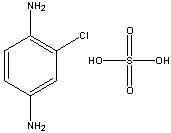
NTP Study Reports

NTP Study Reports
Home » Study Results & Research Projects » NTP Study Reports » All Long-Term Reports » Abstract for TR-113 2-Chloro-p-phenylenediamine

| Chemical Formula: C6H7Cl N2 · H2O4S | - | 3D Structure* | |
|---|---|---|---|
| *To view structure, download free Chemscape Chime Plug-in | |||
2-Chloro-p-phenylenediamine sulfate is a salt of 2-chloro-p-phenylenediamine and sulfuric acid. It is a component of commercial hair dyes and was selected for bioassay by the National Cancer Institute because of the increased bladder cancer incidence noted among dye manufacturing workers.
A bioassay for possible carcinogenicity of 2-chloro-p-phenylenediamine sulfate was conducted using Fischer 344 rats and B6C3F1 mice. 2-Chloro-p-phenylenediamine sulfate was administered in the feed, at either of two concentrations, to groups of 50 male and 50 female animals of each species. The dietary concentrations used in the chronic bioassay were 0.3 and 0.15 percent for the high and low dose rats, respectively, and 0.6 and 0.3 percent for the high and low dose mice, respectively. Compound administration was for 105 to 107 weeks in rats, 87 weeks in high dose mice, and 104 to 105 weeks in low dose mice. The only groups observed during an untreated period after dosing were the high dose mice, observed for 18 weeks after compound administration ceased. For each species, 20 animals of each sex were placed on test as controls.
There were no significant positive associations between the administered dietary concentrations of 2-chloro-p-phenylenediamine sulfate and mortality for rats of either sex or male mice. There was a significant positive association between dosage and mortality for female mice; however, adequate numbers of animals in all groups survived sufficiently long to be at risk from late-developing tumors.
There were no statistically significant positive associations between dietary exposure to the compound and the incidences of any tumor in rats. There was an increased incidence of transitional-cell hyperplasia of the renal pelvic epithelium in both male and female rats, and transitional-cell tumors of the urinary bladder were present in three dosed rats. These lesions indicated a possible carcinogenic effect, but are not considered as sufficient evidence of carcinogenicity. In mice, no tumors occurred in statistically significantly higher incidences in the dosed mice than in controls.
Under the conditions of this bioassay there was insufficient evidence that dietary administration of 2-chloro-p-phenylenediamine sulfate was carcinogenic to Fischer 344 rats and B6C3F1 mice.
| Male Rats: | Negative | |
| Female Rats: | Negative | |
| Male Mice: | Negative | |
| Female Mice: | Negative |
Synonyms: 2-chloro-1,4-benzenediamine sulfate; 3-chloro-4-aminoaniline sulfate; o-chloro-p-phenylenediamine sulfate; C.I. Oxidation Base 13A; Ursol Brown 0
Report Date: 1978
Target Organs from 2-year Studies
You may link to the full technical report in pdf format ( Note: A print ready copy of the document is presented in Portable Document Format (pdf) which requires the Acrobat Reader plug-in -- download a free copy of the reader.)
Web page last updated on October 14, 2004
The National Institute of Environmental Health Sciences is one of the National Institutes of Health within the U.S. Department of Health and Human Services. The National Toxicology Program is headquartered on the NIEHS campus in Research Triangle Park, NC.